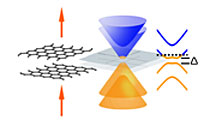- Number 289 |
- June 22, 2009
A Graphene Transistor With a Tunable Bandgap

Electrical fields (arrows) introduce
asymmetry into the bilayer structure,
yielding a bandgap (Δ) that can be
selectively tuned.
By creating a bandgap in bilayer graphene, Feng Wang and his colleagues in the Materials Sciences Division at DOE’s Lawrence Berkeley National Laboratory and UC Berkeley have opened the way for practical electronic and photonic applications of this remarkable material. Single-layer graphene, a two-dimensional crystal of carbon atoms, has no bandgap and behaves like a metal. Results of previous attempts to induce a bandgap in bilayer graphene at temperatures near absolute zero were disappointing. The double-gated FET transistor created by Wang and colleagues works at room temperature and allows the bandgap to be precisely controlled between 0 eV and the infrared.
[Paul Preuss, 510.486.6249,
paul_preuss@lbl.gov]
